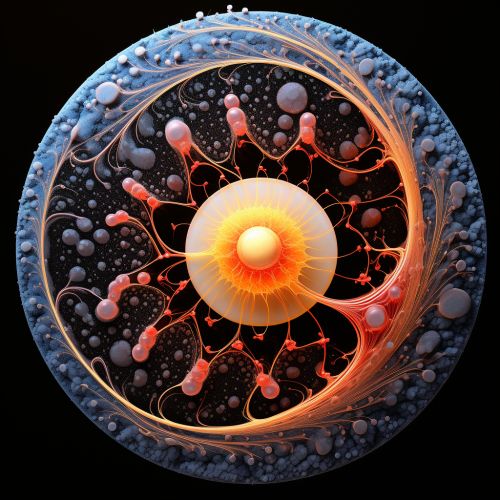Cell cycle
Overview
The Cell cycle is a complex process that cells in most organisms undergo in order to duplicate. This process is vital for growth, development, and repair within organisms. The cell cycle is divided into two main phases: interphase and the mitotic (M) phase. Interphase, which is further divided into the G1, S, and G2 phases, is the period in which the cell grows and duplicates its DNA. The M phase, which includes mitosis and cytokinesis, is when the cell splits into two daughter cells.
Interphase
Interphase is the longest phase of the cell cycle, often taking up about 90% of the total time. This phase is further divided into three stages: G1 (Gap 1), S (Synthesis), and G2 (Gap 2).
G1 Phase
The G1 phase is a period of cellular growth and preparation for DNA replication. During this phase, the cell increases in size, produces RNA and proteins, and prepares for the duplication of its DNA. The G1 phase is also the stage at which the cell checks for DNA damage and, if necessary, repairs it. If the cell does not pass this checkpoint, it may enter a resting state known as G0 phase.


S Phase
The S phase is when DNA replication occurs. The cell's DNA is unwound and each strand is used as a template for the synthesis of a new, complementary strand. This results in two identical copies of each chromosome, each consisting of two sister chromatids. The S phase also involves the replication of the cell's centrosomes, which are crucial for cell division.
G2 Phase
The G2 phase is another period of cellular growth and preparation for division. The cell continues to grow and produce proteins, and checks for any errors in the replicated DNA. If any errors are detected, the cell attempts to repair them before proceeding to the M phase.
Mitotic Phase
The mitotic phase consists of mitosis and cytokinesis. Mitosis is further divided into five stages: prophase, prometaphase, metaphase, anaphase, and telophase.
Prophase
During prophase, the cell's chromatin condenses into chromosomes, and the nuclear envelope breaks down. The centrosomes, which were replicated during the S phase, move to opposite ends of the cell and begin to form the mitotic spindle, a structure that will later separate the sister chromatids.
Prometaphase
In prometaphase, the nuclear envelope is completely broken down, and the chromosomes begin to attach to the mitotic spindle via their kinetochores.
Metaphase
During metaphase, the cell's chromosomes align in the middle of the cell, a region known as the metaphase plate. This alignment ensures that each daughter cell will receive one copy of each chromosome during cell division.


Anaphase
In anaphase, the sister chromatids are separated and pulled towards opposite ends of the cell by the mitotic spindle. This ensures that each daughter cell will receive an identical set of chromosomes.
Telophase and Cytokinesis
During telophase, the chromosomes reach the poles of the cell and begin to decondense, and new nuclear envelopes form around each set of chromosomes. This is followed by cytokinesis, the division of the cytoplasm and the formation of two separate cells.
Regulation of the Cell Cycle
The cell cycle is tightly regulated by a series of checkpoints and proteins, including cyclins and cyclin-dependent kinases (CDKs). These proteins ensure that the cell cycle proceeds correctly and that errors are repaired or prevented.
Implications in Disease
Errors in the cell cycle can lead to diseases such as cancer, in which cells divide uncontrollably. Understanding the cell cycle and its regulation is therefore crucial for the development of treatments for these diseases.
